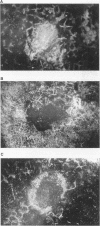Abstract
We examined hepatic artery ligation combined with an angiogenesis inhibitor, TNP-470, in the treatment of VX2 tumour inoculated into the liver of rabbits. Effects on tumour growth were correlated with arterial collateral development in this system. Three treatment methods were compared: (1) the left hepatic artery was ligated at the liver hilum (ligation group); (2) TNP-470 (40 mg per body) was infused continuously for 7 days via the common hepatic artery (TNP group); (3) the left hepatic artery was ligated and TNP-470 was infused continuously for 7 days via the common hepatic artery (ligation + TNP group). These treatments were started 12-14 days after tumour inoculation. The day of initiating treatment was defined as day 0. Although there were no significant differences in tumour volume among the three treated groups on day 7 after treatment, tumour volumes in the ligation + TNP group were significantly smaller than in the ligation group and the TNP group on day 14 after treatment. The vasculature and arterial collaterals around the tumour were demonstrated by the perfusion of a silicon rubber solution, Microfil. In the ligation + TNP group, the new microvasculature around the tumour decreased compared with the ligation group. The TNP-470 inhibition of microvascular proliferation may limit the development of collaterals that communicate with new feeding arteries. These results suggest that transarterial embolization combined with TNP-470 may enhance the anti-tumour effect of transarterial embolization alone in the treatment of liver tumours.
Full text
PDF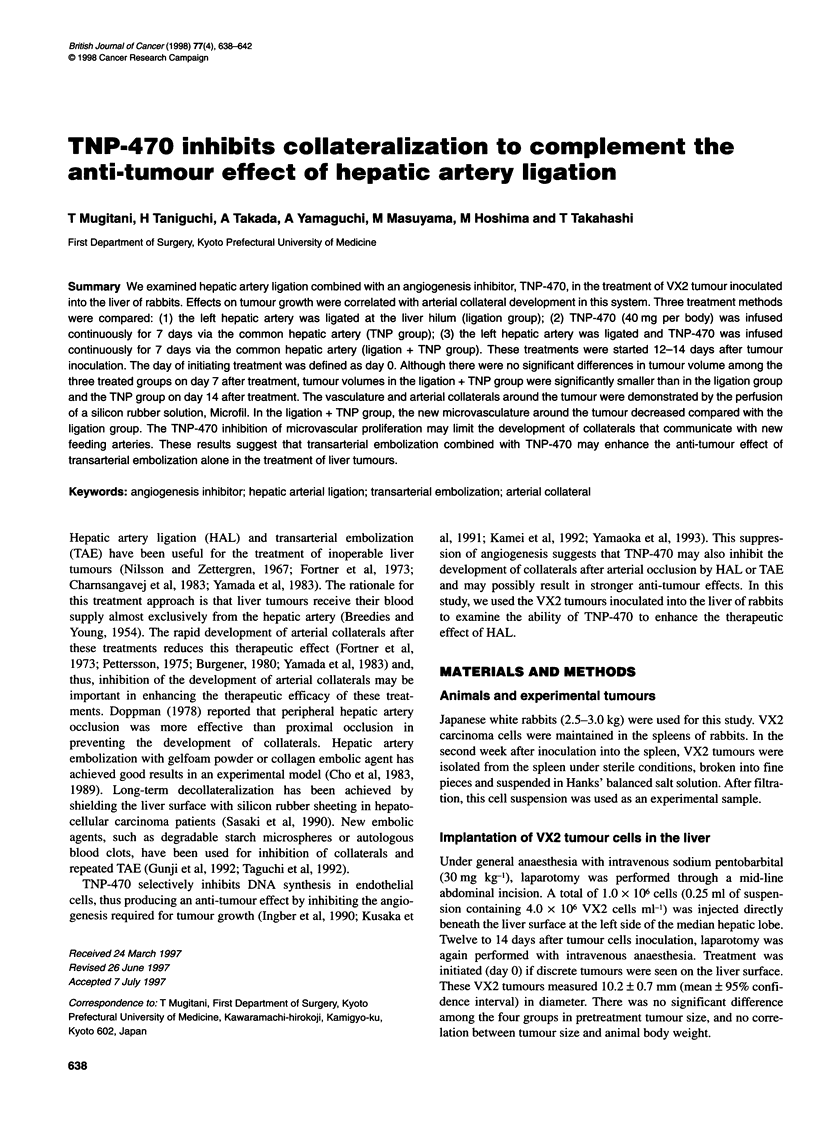
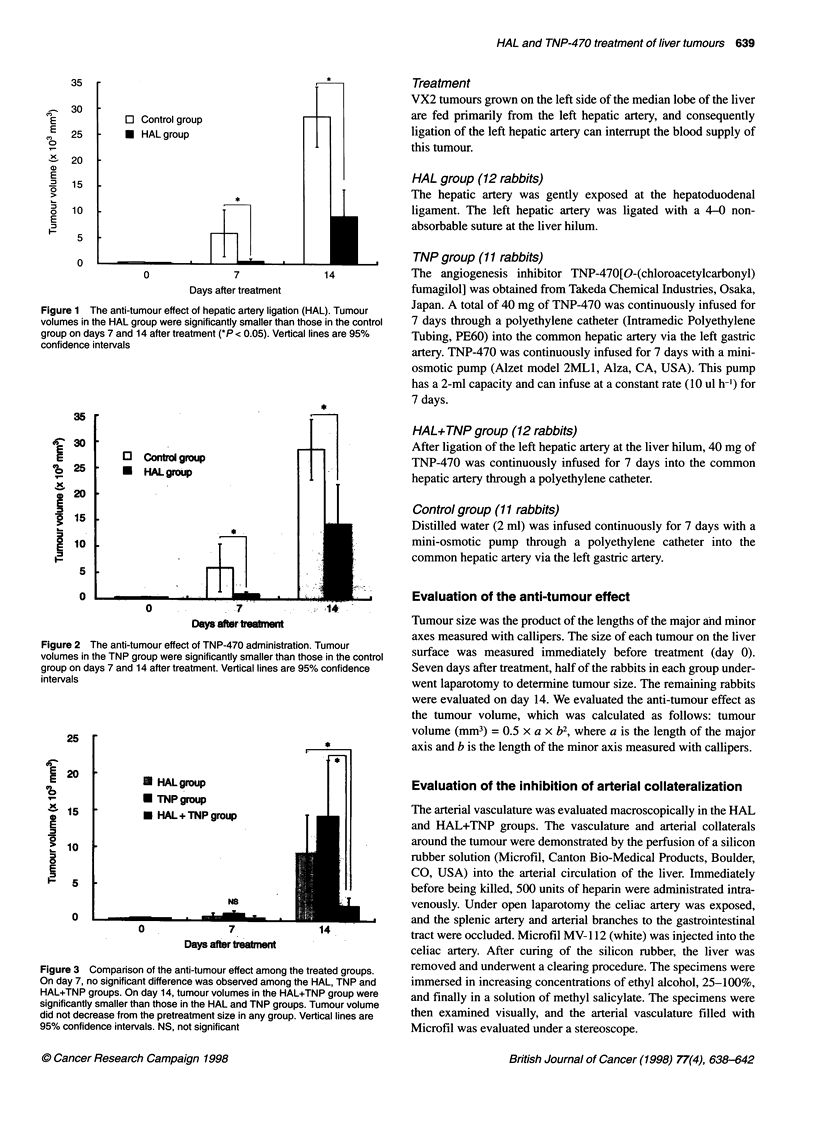
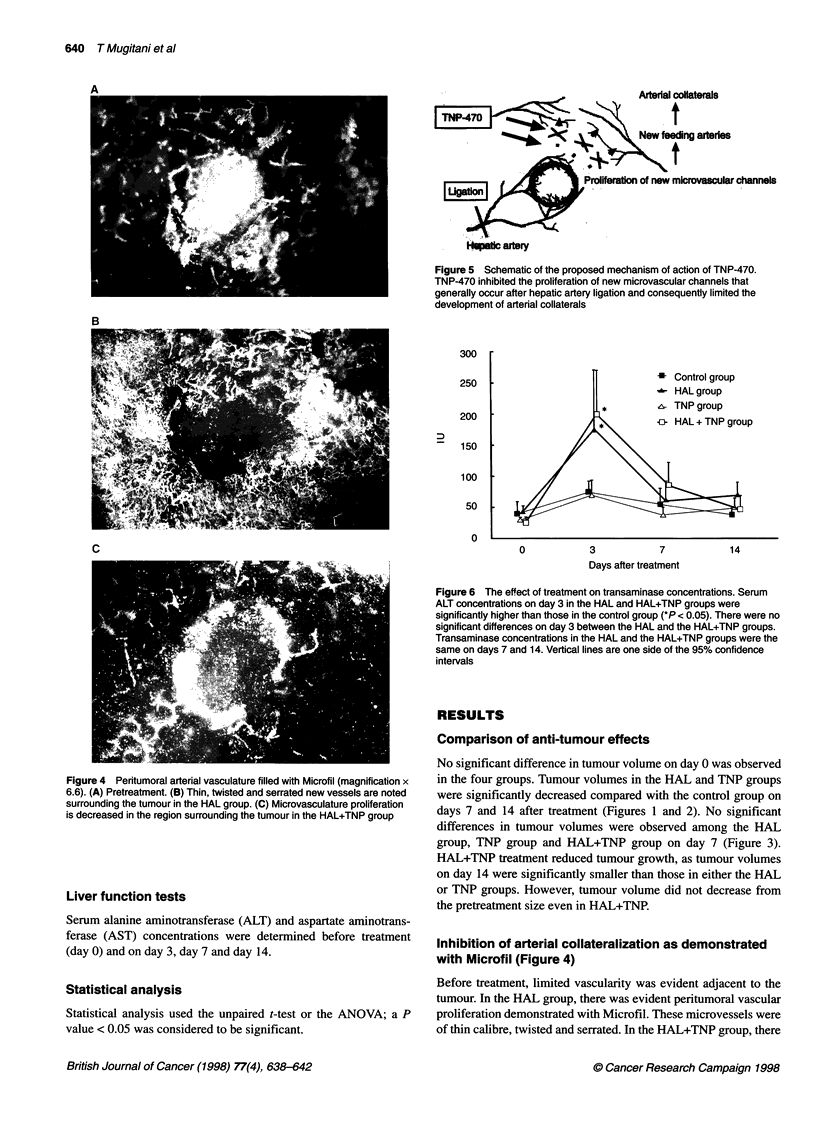
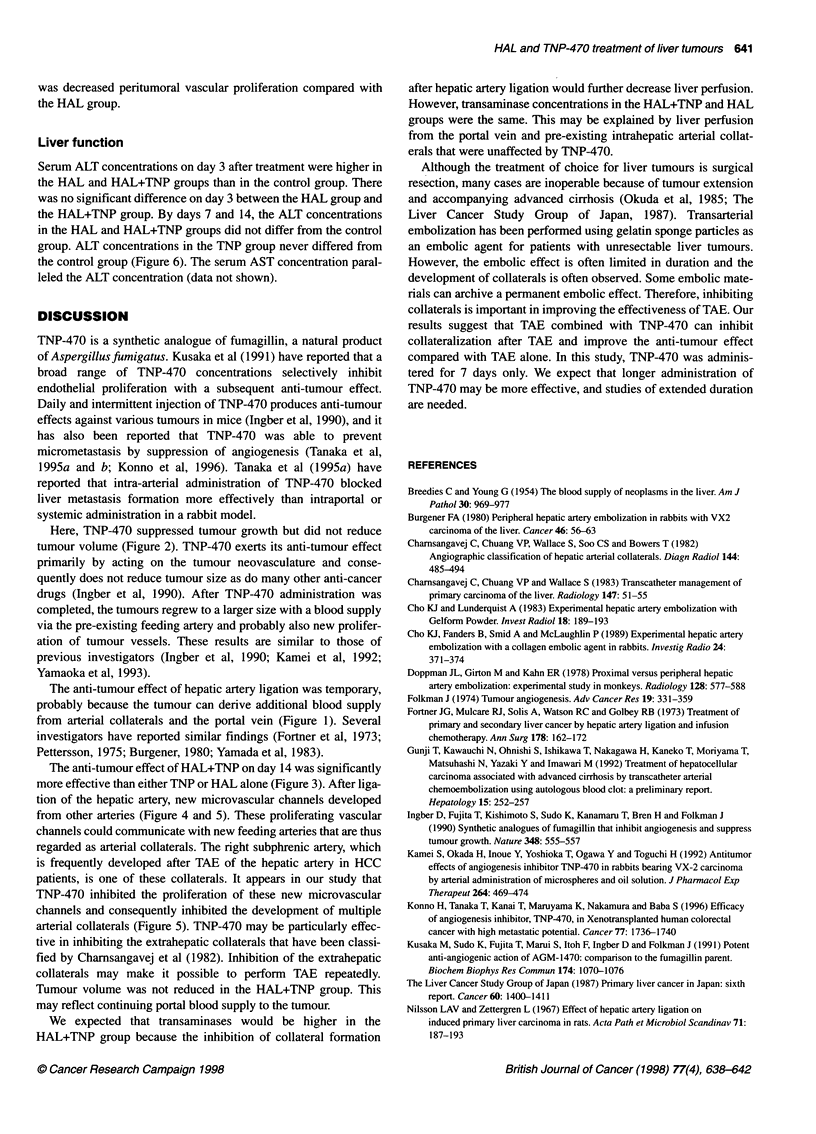
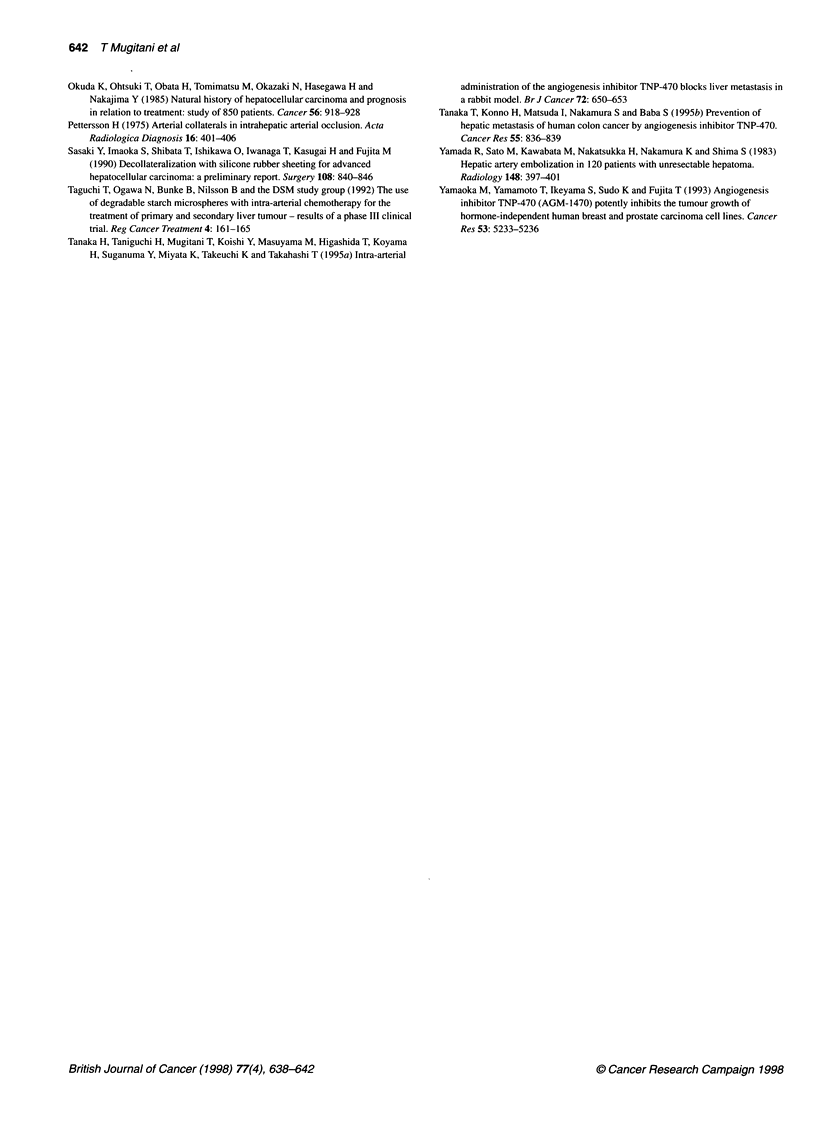
Images in this article
Selected References
These references are in PubMed. This may not be the complete list of references from this article.
- BREEDIS C., YOUNG G. The blood supply of neoplasms in the liver. Am J Pathol. 1954 Sep-Oct;30(5):969–977. [PMC free article] [PubMed] [Google Scholar]
- Burgener F. A. Peripheral hepatic artery embolization in rabbits with VX2 carcinomas of the liver. Cancer. 1980 Jul 1;46(1):56–63. doi: 10.1002/1097-0142(19800701)46:1<56::aid-cncr2820460113>3.0.co;2-c. [DOI] [PubMed] [Google Scholar]
- Charnsangavej C., Chuang V. P., Wallace S., Soo C. S., Bowers T. Angiographic classification of hepatic arterial collaterals. Radiology. 1982 Aug;144(3):485–494. doi: 10.1148/radiology.144.3.6285413. [DOI] [PubMed] [Google Scholar]
- Charnsangavej C., Chuang V. P., Wallace S., Soo C. S., Bowers T. Work in progress: transcatheter management of primary carcinoma of the liver. Radiology. 1983 Apr;147(1):51–55. doi: 10.1148/radiology.147.1.6298860. [DOI] [PubMed] [Google Scholar]
- Cho K. J., Fanders B., Smid A., McLaughlin P. Experimental hepatic artery embolization with a collagen embolic agent in rabbits. A microcirculatory study. Invest Radiol. 1989 May;24(5):371–374. doi: 10.1097/00004424-198905000-00007. [DOI] [PubMed] [Google Scholar]
- Cho K. J., Lunderquist A. Experimental hepatic artery embolization with Gelfoam powder. Microfil perfusion study of the rabbit liver. Invest Radiol. 1983 Mar-Apr;18(2):189–193. doi: 10.1097/00004424-198303000-00017. [DOI] [PubMed] [Google Scholar]
- Doppman J. L., Girton M., Kahn R. Proximal versus peripheral hepatic artery embolization experimental study in monkeys. Radiology. 1978 Sep;128(3):577–588. doi: 10.1148/128.3.577. [DOI] [PubMed] [Google Scholar]
- Folkman J. Tumor angiogenesis. Adv Cancer Res. 1974;19(0):331–358. doi: 10.1016/s0065-230x(08)60058-5. [DOI] [PubMed] [Google Scholar]
- Fortner J. G., Mulcare R. J., Solis A., Watson R. C., Golbey R. B. Treatment of primary and secondary liver cancer by hepatic artery ligation and infusion chemotherapy. Ann Surg. 1973 Aug;178(2):162–172. doi: 10.1097/00000658-197308000-00009. [DOI] [PMC free article] [PubMed] [Google Scholar]
- Gunji T., Kawauchi N., Ohnishi S., Ishikawa T., Nakagama H., Kaneko T., Moriyama T., Matsuhashi N., Yazaki Y., Imawari M. Treatment of hepatocellular carcinoma associated with advanced cirrhosis by transcatheter arterial chemoembolization using autologous blood clot: a preliminary report. Hepatology. 1992 Feb;15(2):252–257. doi: 10.1002/hep.1840150213. [DOI] [PubMed] [Google Scholar]
- Ingber D., Fujita T., Kishimoto S., Sudo K., Kanamaru T., Brem H., Folkman J. Synthetic analogues of fumagillin that inhibit angiogenesis and suppress tumour growth. Nature. 1990 Dec 6;348(6301):555–557. doi: 10.1038/348555a0. [DOI] [PubMed] [Google Scholar]
- Kamei S., Okada H., Inoue Y., Yoshioka T., Ogawa Y., Toguchi H. Antitumor effects of angiogenesis inhibitor TNP-470 in rabbits bearing VX-2 carcinoma by arterial administration of microspheres and oil solution. J Pharmacol Exp Ther. 1993 Jan;264(1):469–474. [PubMed] [Google Scholar]
- Konno H., Tanaka T., Kanai T., Maruyama K., Nakamura S., Baba S. Efficacy of an angiogenesis inhibitor, TNP-470, in xenotransplanted human colorectal cancer with high metastatic potential. Cancer. 1996 Apr 15;77(8 Suppl):1736–1740. doi: 10.1002/(SICI)1097-0142(19960415)77:8<1736::AID-CNCR48>3.0.CO;2-Y. [DOI] [PubMed] [Google Scholar]
- Kusaka M., Sudo K., Fujita T., Marui S., Itoh F., Ingber D., Folkman J. Potent anti-angiogenic action of AGM-1470: comparison to the fumagillin parent. Biochem Biophys Res Commun. 1991 Feb 14;174(3):1070–1076. doi: 10.1016/0006-291x(91)91529-l. [DOI] [PubMed] [Google Scholar]
- Nilsson L. A., Zettergren L. Effect of hepatic artery ligation on induced primary liver carcinoma in rats. Preliminary report. Acta Pathol Microbiol Scand. 1967;71(2):187–193. doi: 10.1111/j.1699-0463.1967.tb05157.x. [DOI] [PubMed] [Google Scholar]
- Okuda K., Ohtsuki T., Obata H., Tomimatsu M., Okazaki N., Hasegawa H., Nakajima Y., Ohnishi K. Natural history of hepatocellular carcinoma and prognosis in relation to treatment. Study of 850 patients. Cancer. 1985 Aug 15;56(4):918–928. doi: 10.1002/1097-0142(19850815)56:4<918::aid-cncr2820560437>3.0.co;2-e. [DOI] [PubMed] [Google Scholar]
- Pettersson H. Arterial collaterals in intrahepatic arterial occlusion. Acta Radiol Diagn (Stockh) 1975 Jul;16(4):401–406. doi: 10.1177/028418517501600412. [DOI] [PubMed] [Google Scholar]
- Sasaki Y., Imaoka S., Shibata T., Ishikawa O., Iwanaga T., Kasugai H., Fujita M. Decollateralization with silicone rubber sheeting for advanced hepatocellular carcinoma: a preliminary report. Surgery. 1990 Nov;108(5):840–846. [PubMed] [Google Scholar]
- Tanaka H., Taniguchi H., Mugitani T., Koishi Y., Masuyama M., Higashida T., Koyama H., Suganuma Y., Miyata K., Takeuchi K. Intra-arterial administration of the angiogenesis inhibitor TNP-470 blocks liver metastasis in a rabbit model. Br J Cancer. 1995 Sep;72(3):650–653. doi: 10.1038/bjc.1995.389. [DOI] [PMC free article] [PubMed] [Google Scholar]
- Tanaka T., Konno H., Matsuda I., Nakamura S., Baba S. Prevention of hepatic metastasis of human colon cancer by angiogenesis inhibitor TNP-470. Cancer Res. 1995 Feb 15;55(4):836–839. [PubMed] [Google Scholar]
- Yamada R., Sato M., Kawabata M., Nakatsuka H., Nakamura K., Takashima S. Hepatic artery embolization in 120 patients with unresectable hepatoma. Radiology. 1983 Aug;148(2):397–401. doi: 10.1148/radiology.148.2.6306721. [DOI] [PubMed] [Google Scholar]
- Yamaoka M., Yamamoto T., Ikeyama S., Sudo K., Fujita T. Angiogenesis inhibitor TNP-470 (AGM-1470) potently inhibits the tumor growth of hormone-independent human breast and prostate carcinoma cell lines. Cancer Res. 1993 Nov 1;53(21):5233–5236. [PubMed] [Google Scholar]



